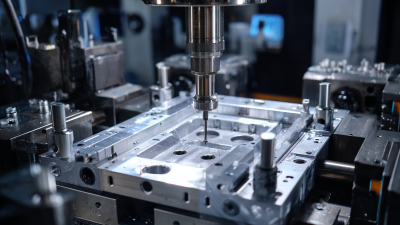The Ultimate Guide to Choosing the Best Union Tool for Your Project
In today's fast-paced industrial landscape, selecting the right union tool for your project can significantly impact efficiency and overall outcomes. According to a recent report from the National Institute of Standards and Technology (NIST), improper tool selection can lead to up to a 30% decrease in productivity for manufacturers. As projects grow increasingly complex, the importance of investing in high-quality union tools becomes paramount; research indicates that utilizing the appropriate tool can enhance precision and reduce error rates by as much as 25%.

With a myriad of options available—from traditional hand tools to advanced machinery—understanding the functionalities, compatibility, and applications of various union tools is essential for professionals aiming to optimize their workflows and achieve superior results. In this ultimate guide, we will explore key factors to consider when choosing the best union tool tailored to your specific project requirements.
Understanding Different Types of Union Tools for Your Specific Needs
When selecting a union tool for your project, it's essential to understand the various types available and how each serves specific needs. Union tools are pivotal in uniting different components, and they come in several forms, including pipe fittings, electrical connectors, and mechanical unions. Each type is designed to facilitate seamless assembly and disassembly, making them invaluable for maintenance and repairs. For instance, pipe union tools are particularly effective in plumbing applications where quick access to pipelines is necessary, while electrical union tools are crucial in ensuring secure connections in wiring jobs.
Moreover, considering the materials and sizes of union tools is vital for matching them to your project requirements. Steel and brass unions are commonly used for their durability and resistance to corrosion, while PVC unions may suit less demanding applications. Additionally, the size must be appropriate for the valves or pipes in your project to ensure a proper fit. Understanding these distinctions will help you choose a union tool that optimally meets your project's demands, leading to efficient and effective outcomes.
The Ultimate Guide to Choosing the Best Union Tool for Your Project
Key Features to Look for in Quality Union Tools
When selecting the best union tool for your project, there are several key features to keep in mind. Firstly, consider the material and durability of the tool. High-quality union tools are typically made from robust materials that can withstand heavy usage, ensuring longevity and reliability. Look for tools that are designed to provide a strong grip as well; ergonomically designed handles can make a significant difference during prolonged use.
Another crucial feature is versatility. The best union tools should be adaptable to various tasks, allowing you to tackle different aspects of your project without needing multiple tools. This saves both time and money, making your workflow more efficient. Additionally, ensure that the tool has appropriate safety features to prevent accidents during operation.
**Tips:** Always read reviews and comparisons to identify which brands consistently deliver quality. Additionally, consider investing in a tool set that includes multiple types of union tools; this will equip you for a wider range of projects while also ensuring that you have reliable equipment on hand whenever needed. Finally, don’t overlook the importance of warranty and customer support, as these can provide peace of mind for your investment.

Comparing Material Durability and Functionality in Union Tools
When selecting the optimal union tool for your project, understanding the durability and functionality of various materials is crucial. Union tools come in multiple materials, each with distinct advantages and ideal applications. For instance, steel union tools are renowned for their strength and resistance to wear, making them an excellent choice for high-pressure environments where durability is paramount. Their robustness means they can withstand significant force without failing, ensuring longevity in heavy-duty tasks.

On the other hand, plastic union tools offer a lightweight alternative that excels in applications involving corrosive substances. While they may not match steel in strength, plastics like PVC or CPVC resist many chemicals, making them indispensable in plumbing or chemical handling scenarios. They also tend to be more cost-effective and easier to handle, providing a significant benefit where weight and ease of installation are concerns. Understanding these material differences allows you to make an informed decision tailored to your specific project requirements.
Tips for Maintaining and Extending the Life of Your Union Tools
When it comes to extending the life of your union tools, proper maintenance is paramount. According to a report by the American Tool Manufacturers Association, tools that receive regular maintenance can last up to 30% longer than those that are neglected. Simple practices, such as cleaning your tools after each use and ensuring they are properly lubricated, can significantly reduce wear and tear. It's essential to check for any visible signs of rust or damage regularly; treating these issues early can prevent further deterioration and maintain the tool's performance.
Additionally, the way you store your union tools can have a profound impact on their longevity. A study published by the National Institute of Standards and Technology found that tools stored in controlled environments, away from extreme temperature fluctuations and humidity, experience significantly less degradation. Utilizing toolboxes or cabinets designed to protect against moisture can keep your union tools in optimal condition. By understanding and implementing these maintenance tips, you can not only enhance the performance of your tools but also ensure they serve you well for years to come.
Budgeting for Union Tools: Balancing Quality and Cost for Your Project
When embarking on a project requiring union tools, budgeting becomes a crucial factor. It’s essential to establish a clear budget that aligns with your project’s overall goals. Quality tools may come with a higher price tag, but investing in durable and reliable tools can save you money in the long run by reducing the frequency of replacements and repairs. Always remember, the cheapest option may end up being the most expensive if it fails to perform efficiently.
**Tips:** Consider creating a list of must-have tools and researching their average costs. This allows you to assess your budget against your needs. Additionally, explore bulk purchasing options or tool-sharing programs which can help stretch your budget further without compromising on quality.
Another wise approach is to prioritize tools based on their frequency of use. Invest more in the tools you will use consistently, while seeking budget-friendly options for those that are only needed occasionally. This strategy not only enhances your project’s efficiency but also optimizes your overall spending on union tools.
The Ultimate Guide to Choosing the Best Union Tool for Your Project
| Tool Type | Quality Rating (1-5) | Average Cost ($) | Recommended Use |
|---|---|---|---|
| Union Drill | 4 | 150 | Wood and Metal |
| Union Saw | 5 | 250 | Precision Cutting |
| Union Wrench | 3 | 75 | General Repairs |
| Union Hammer | 4 | 40 | Construction |
| Union Screwdriver | 4 | 30 | Assembly Tasks |
Related Posts
-

Exploring the Future of Union Tool: Innovations and Applications in Today’s Industry
-

Understanding the Process: How Injection Molding Molds Shape Our Daily Products
-

Innovative Molding Tools for Streamlined Manufacturing Processes
-

Exploring Innovations in Plastic Manufacturing: Sustainable Solutions for Tomorrow
-

Revolutionizing Injection Mold Design: Exploring Advanced Techniques and Their Impact on Production Efficiency
